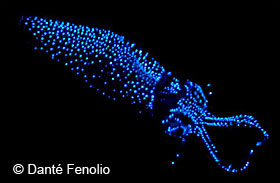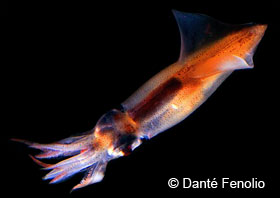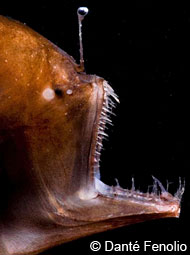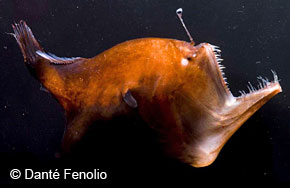Supreme potato dude2 Sean
http://www.seasky.org/deep-sea/deep-sea-menu.html
http://www.seasky.org/deep-sea/ocean-layers.html#Zone3
Firefly Squid
(Watasenia scintillans)
 Of all the bioluminescent life forms in the deep sea, there is one tiny creature who's light show puts all others to shame. This is the firefly squid, sometimes called the sparkling enope squid. Known to science as Watasenia scintillans, it is referred to in Japan as "hotaru-ika". It is a member of the cephalopod family and is related to many other squid species throughout the world's oceans. The firefly squid gets its name from the flashing lights that resemble those of a firefly. This squid is famous for the incredible light show that occurs each year off the coast of Japan as millions of these tiny animals gather to spawn.
Of all the bioluminescent life forms in the deep sea, there is one tiny creature who's light show puts all others to shame. This is the firefly squid, sometimes called the sparkling enope squid. Known to science as Watasenia scintillans, it is referred to in Japan as "hotaru-ika". It is a member of the cephalopod family and is related to many other squid species throughout the world's oceans. The firefly squid gets its name from the flashing lights that resemble those of a firefly. This squid is famous for the incredible light show that occurs each year off the coast of Japan as millions of these tiny animals gather to spawn.

Firefly squid with its amazing light show
(Image courtesy of Danté Fenolio)
The firefly squid is a small member of the squid family, growing to a length of only three inches (seven centimeters). The squid is equipped with special light-producing organs called photophores. These photophores are found on many parts of the squid's body and emit a deep blue light. Large photophores can be found on the tips of the tentacles as well as around the eyes. Thousands of tiny photophores can be found throughout the squid's body, giving it the ability to emit light along its entire form. The lights can be flashed in unison or alternated in an endless number of animated patterns. These light shows are thought to serve several functions. They can be used to communicate with potential mates or rivals. They may also be used to disguise the squid's shape and confuse predators, allowing it to escape. The firefly squid is the only member of the squid family that is believed to have color vision. While most cephalopods have only one visual pigment, firefly squid have three. They also have a double-layered retina in the back of the eye. These adaptations for color vision may have evolved to enable firefly squid to distinguish between ambient light and bioluminescence, and to help them decode the patterns of light created by other members of the species.
The firefly squid is an active predator. It is believed that the squid can use their blue lights to attract prey. By flashing the lights on and off, they can attract small fish and then pounce on them with their powerful tentacles. Firefly squid spend their days at depths of about 1,200 feet (365 meters). At night, they migrate up to the surface to search for food before returning the the darkness below.

Firefly squid shown in natural light
(Image courtesy of Danté Fenolio)
The spawning season of the firefly squid runs from March to May. During this time, the squid can be seen gathering in large numbers in Toyama Bay in Japan. They gather here by the millions, and sometimes by the billions, to lay their eggs. Once the eggs have been released into the water and fertilized, the adult squid begin to die. This completes the one-year life cycle of the squid. This annual light show is so spectacular that the area where they gather has been designated as a special natural monument. Toyama Bay lies above a deep, v-shaped canyon in which the sea floor drops away suddenly. The flow of the ocean currents usually wells up from the bottom of this canyon and pushes the squid to the surface. Occasionally the squid can be found washed up on the shore in large numbers during a phenomenon referred to by locals as "squid drowning themselves". This event can cover the shoreline for miles, bathing the beaches in an erie blue glow.
Firefly squid are found throughout the western Pacific Ocean where they can typically be found at depths ranging from 600 to 1,200 feet (182 to 365 meters). This squid is considered a delicacy in Japan and is widely fished there during the spawning season. As fishing boats haul in their catches, the sea surface begins to glow a bright cobalt blue. The spectacle is so amazing that tourists travel with sight seeing boats just to watch the show.
The Deep Sea Anglerfish
(Melanocetus johnsoni)
 The deep sea anglerfish is one of the most bizarre-looking fish in the sea. Known scientifically as Melanocetus johnsoni, it is also one of the best-known creatures of the deep. It is one of about 200 species of anglerfish found throughout the world's oceans. The angler gets its name from the elongated dorsal spine that supports a light-producing organ known as a photophore. Through a chemical process known as bioluminescence, this photophore can produce a blue-green light similar to that of a firefly on land. The fish uses this appendage like a fishing lure, waving it back and forth to attract its prey.
The deep sea anglerfish is one of the most bizarre-looking fish in the sea. Known scientifically as Melanocetus johnsoni, it is also one of the best-known creatures of the deep. It is one of about 200 species of anglerfish found throughout the world's oceans. The angler gets its name from the elongated dorsal spine that supports a light-producing organ known as a photophore. Through a chemical process known as bioluminescence, this photophore can produce a blue-green light similar to that of a firefly on land. The fish uses this appendage like a fishing lure, waving it back and forth to attract its prey.

Closeup of female anglerfish
showing its large teeth & lure
(Image courtesy of Danté Fenolio)
The deep sea anglerfish has a round body that resembles a basketball, and indeed, it looks like it could easily swallow one. It has a very large mouth with sharp, fang-like teeth. Its grotesque appearance has earned it the nickname "common black devil". Despite its ferocious appearance, the angler is a small fish, reaching a maximum length of only about five inches (12 centimeters). The color of this anglerfish ranges from brown to dark gray or black. It has soft flesh and bones and small eyes. Its skin is specially adapted to reflect blue light. Since nearly all light emitted from bioluminescent creatures is blue, the anglerfish can be nearly invisible to other deep sea animals. Due to its wide, round body, it cannot swim very fast. Instead, it somewhat "wobbles" through the water.
The anglerfish uses its illuminated lure as its hunts for prey. This specialized spine is highly maneuverable and can be moved in any direction. The anglerfish is known to remain completely motionless, waving its lure back and forth like a fishing pole. When the prey fish gets close enough, the angler snaps it up with its powerful jaws and swallows it whole. The sharp teeth of the angler are angled inwards, which helps to prevent the prey from escaping. The anglerfish can extend both its jaw and its stomach to an incredible size, allowing it to swallow prey twice the size of its entire body. Since food can be scarce in the deep sea, this special adaptation allows it to stock up on food during times of plenty.

Image of a female deep sea anglerfish
(Image courtesy of Danté Fenolio)
The deep sea anglerfish has an extremely unusual method of reproduction. The male angler is much smaller than the female and completely different in appearance. It is about the size of a small finger and black in color. When a male angler matures, its digestive system degenerates, making it impossible for it to feed on its own. It must now find a female or die of starvation. The male angler has small hook teeth, which it uses to attach itself to the female. Once he bites into her skin, he releases an enzyme that dissolves the skin of his mouth and that of her body. The two become fused together and their blood vessels join as one. The male will spend the rest of its life joined to the female like a parasite, getting all of his nourishment from her body. A female can carry up to six males on her body at a time. This bizarre method of reproduction helps to ensure that when the female is ready to spawn, she has a mate instantly available. The female will lay her eggs in a thin sheet of gelatinous material two or three feet (about one meter) wide and about 30 feet (9 meters) long. This thin sheet of eggs floats free in the sea until the eggs hatch into tiny larvae. Once hatched, the larvae swim to the surface and feed on plankton. As they mature, they return to the depths below.
The deep sea angler is found throughout the world's oceans at depths of over 3,000 feet (914 meters). At this depth, there is almost no light and the water is near freezing. Many species of anglerfish are fished commercially throughout the world. They are compared to lobster in taste and texture. In Japan, anglerfish is considered a delicacy and can fetch a premium price.
Fangtooth
(Anoplogaster cornuta)
 Looking like it just swam out of a horror movie is the amazing fangtooth. Known scientifically as Anoplogaster cornuta, this menacing creature haunts the deep waters of many of the world's oceans. The fangtooth gets its name from its rather impressive looking teeth, which are actually the largest teeth of any fish in the ocean when taken in proportion to body size. Because of its unusually grotesque appearance, the fangtooth has earned the nickname "ogrefish". It is also referred to by some as the common sabretooth.
Looking like it just swam out of a horror movie is the amazing fangtooth. Known scientifically as Anoplogaster cornuta, this menacing creature haunts the deep waters of many of the world's oceans. The fangtooth gets its name from its rather impressive looking teeth, which are actually the largest teeth of any fish in the ocean when taken in proportion to body size. Because of its unusually grotesque appearance, the fangtooth has earned the nickname "ogrefish". It is also referred to by some as the common sabretooth.
Although the fangtooth may look like a true monster, it is actually a small fish, reaching a maximum length of only six inches (16 centimeters). It has a short, deep body and with a large head and mouth. The head contains numerous mucous cavities separated by serrated ridges. These cavities are covered over with thin skin. The body of this fish is covered with small, prickly scales, and its color varies from black to dark brown. It has very small eyes that are set high on the head. To compensate for relatively poor eyesight, the fangtooth has developed an unusually prominent lateral line which helps it to sense movement and vibration from the surrounding water.
Undoubtedly the most noticeable characteristic of this species is the teeth. They are so large that the fangs on the lower jaw actually slide into specially formed pockets in the roof of the mouth when the jaw is closed. These pockets extend into sockets on either side of the brain. These teeth become a formidable weapon as the fangtooth hunts squid other small fish. Because its eyesight is not good, many researchers think the fangtooth hunts by a process known as chemoreception, where it essentially must bump into something edible as it searches the dark waters. It is believed that these fish migrate to upper layers of the ocean to feed during the night and then return to the murky depths during the day. If a fangtooth wanders too close to the surface, it risks becoming a meal for larger fish species such as marlin or tuna.
Fangtooth reproduce by laying eggs that hatch to reveal tiny plankton-sized larvae. Their spawning frequency is not well known, although it has been observed between June and August. As the larvae eventually grow into the juvenile stage, they look completely different from the adults. They are light gray in color with long spines on their heads. They also have larger eyes and slightly smaller teeth. This difference in appearance initially caused scientists to assume that it was a different species entirely. Unlike the adults, the juveniles feed by filtering plankton from the water using specially formed gill rakes. These gill rakes disappear as they reach maturity. The juveniles begin to resemble the adults when they reach a size of about three inches. At this time they begin to descend down to deeper waters. Scientists still do not know how long they live.
The fangtooth is found throughout the world in temperate and tropical ocean regions including the waters off the coast of Australia. It is one of the deepest living fish species yet discovered. These fish are commonly seen between 600 and 6,500 feet (200 - 2,000 meters), but have been observed as deep as 16,000 feet (5,000 meters). The pressure at these great depths is intense and the water temperature is near freezing. The fangtooth is more robust than other deep water species. Researchers have been able to keep them alive for months in captivity in spite of the vast differences in temperature and pressure.
Giant Isopod
(Bathynomus giganteus)
Looking like it just crawled out of a bad science fiction movie, the giant isopod is without a doubt one of the strangest creatures found in the deep sea. Known scientifically as Bathynomus giganteus, it is one of about nine members of the genus Bathynomus. It is also the largest known members of the isopod family, a group of crustaceans closely related to shrimps and crabs. The giant isopod is also related to the small pillbugs that you can find in the garden. In fact, this insect-like creature is sometimes referred to as the giant pillbug. Giant isopods are not usually fished commercially, although some can be found in the occasional oceanside restaurant in northern Taiwan, where they are boiled and served with rice.
The enormous size of the giant isopod is a result of a phenomenon known as deep sea gigantism. This is the tendency of deep sea crustaceans and other animals to grow to a much larger size than similar species in shallower waters. Other examples of this would be the giant squid and the giant tube worm. The giant squid grows to a length of up to 60 feet in the deep sea. In comparison, its shallow water cousins only grow to about two feet in length. The reason for these size differences remains a mystery, although some researchers believe it may be an adaptation to help the animal deal with the enormous pressures.
The giant isopod can grow to a length of over 16 inches, which makes it one of the largest members of the crustacean family. Like its terrestrial cousin, the pillbug, the giant isopod's body is protected by a hard shell that is divided into segments. This allows it to be strong and flexible at the same time. When threatened, this animal can roll itself into a ball to protect its vulnerable underside. And just like its land-based counterpart, the isopod has compound eyes, with over 4,000 individual facets. This gives the animal a large field of view, and makes it extremely sensitive to fast movements. Because light is extremely faint in the deep sea, the giant isopod has developed large antennae to help it feel its way around as it crawls along the ocean floor.
The giant isopod is a carnivorous crustacean that spends its time scavenging the deep sea floor. Food is extremely scarce at these great depths, so the isopod has adapted to eat what ever happens to fall from above. This includes the bodies of dead whales, fish, and squid. It is believed that the isopod will also feed on some slow-moving animals such as sea cucumbers and sponges. The giant isopod has a complex mouth that with many components that work together to pierce, shred, and disembowel their prey. The isopod can go for long periods of time without eating and has been known to survive over eight weeks without food in when kept in captivity.
Giant isopods reproduce by laying eggs. These eggs are thought to be the largest of all the marine invertebrates. The females develop a pouch known as a marsupium, where the eggs are stored until the young are ready to emerge. When this happens, the young isopods escape from the marsupium as fully formed miniatures of the adults. At this stage, they are known as manca and are nearly fully developed. Bypassing the larval stage greatly enhances the young isopod's chances of survival.
Giant isopods are found in most oceans of the world. Their habitat ranges in depth from the dimly lit sublittoral zone at 550 ft (170 m) to the pitch darkness of the bathypelagic zone at 7,020 ft (2,140 m). They prefer mud or clay ocean bottom areas where they prefer to live solitary lives.
Comments (3)
June Shanahan said
at 3:53 pm on Apr 21, 2009
Dear Sean,
You have some very cool links, but REMEMBER that all links must be about your creature. Any links to games should be on topic. If you want to link learning games, just figure out a way to create and link a page to your "All About Me" poetry. That would be 100% fun!
Sean said
at 4:17 pm on Apr 21, 2009
http://www.mrnussbaum.com/probfair/index.html
http://www.lego.com/en-US/products/default.aspx
http://www.primarygames.com/
http://www.learningplanet.com/act/mayhem/index.asp
http://www.seasky.org/deep-sea/deep-sea-menu.html
http://www.seasky.org/deep-sea/ocean-layers.html#Zone3
Tyler said
at 1:30 pm on Apr 22, 2009
OMG! O_o
You don't have permission to comment on this page.